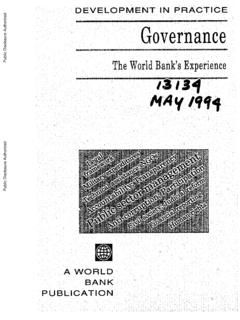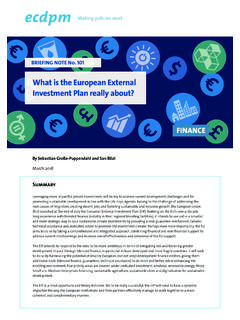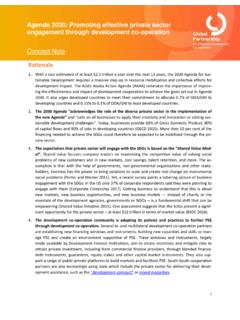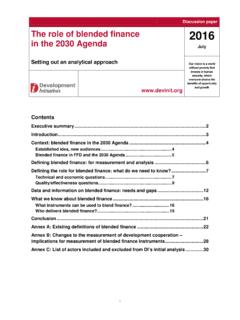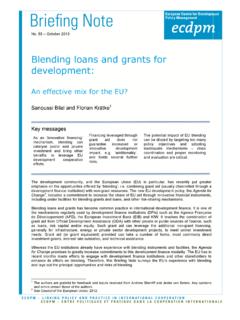Transcription of Water Revolving Fund in the Philippines - World Bank
1 CASE STUDIES IN blended finance FOR Water AND SANITATIONW ater Revolving fund in the PhilippinesAugust 2016 Summary OverviewLocation: Philippines , Southeast AsiaApproach to blended finance : The philippine Water Revolving fund (PWRF) was set up in 2008 to provide loans to Water service providers local government units (LGUs) and Water districts (WDs) to finance local Water and wastewater projects. Loan repayments made into the fund are revolved to finance other projects. The PWRF blends Official Development Assistance (ODA) and domestic public funds with commercial financ-ing to lower borrowing rates, and to market Water and sanitation projects to private finance institutions (PFIs). Concessional seed financing from the Japan Bank for International Cooperation (JBIC), was provided to the PWRF at the start of the program. The financing is backed by a standby credit line (to protect against liquid-ity risk) and a co-guarantor credit the Philippines , financing for the Water and sanita-tion sector traditionally came from a combination of international development funds, domestic public funds, and revenues from bill collection.
2 In the 1990s, such funds proved insufficient to cover infrastructure invest-ment costs, which generated increased attention for mobilizing private sector financing. Legal and regula-tory reforms were initiated to make way for mobilizing domestic finance . In 2004, Executive Order 279 modified the financing policies for local Water service providers. This led to the establishment of a system to categorize Water service providers, including local government units (LGUs) and Water districts (WDs) according to their levels of creditworthiness: those qualifying as creditworthy were expected to shift away from government financing and mobilize market-based financing sources. However, lending from private banks to Water utilities was virtu-ally nonexistent at that time, as local commercial banks were not familiar with utilities and saw them as weak and inefficient. To address those challenges, the United States Agency for International Development (USAID) and Japan Bank for International Cooperation (JBIC) worked in partner-ship with the Government of the Philippines to create the philippine Water Revolving fund (PWRF) and help mobilize additional domestic commercial financing for Water utilities through blending with ODA funding.
3 The PWRF was set up in 2008 as a co-financing facility with the purpose of facilitating private institutional financing to support municipal Water and wastewater projects. The PWRF program is multifaceted in its approach to address obstacles that prevent the flow of commercial finance into the Water sector, and involved support in three key areas: innovative financing, operational strengthening, and regulatory reforms. Innovative financing includes the establishment of a Revolving fund mechanism, the philippine Water Revolving fund (PWRF) as well as two complementary 42431 | AUGUST 2016 Public Disclosure AuthorizedPublic Disclosure AuthorizedPublic Disclosure AuthorizedPublic Disclosure Authorized2 Water Global PracticeCase Studies in blended finance for Water and Sanitation: Water Revolving fund in the Philippinesfinancial market-enabling components: (1) a credit rating system to help inform investors; and (2) a Water project appraisal training program to build the capacity of lend-ers with little prior experience of investing in the Water sector.
4 For the operational strengthening component, the objective was to help utilities improve internal operations and creditworthiness, thereby allowing them to develop bankable projects. Finally, regulatory reform efforts helped improve the enabling environment for commercial finance lending to Water Structure and Approach to blended FinanceThe PWRF on-lends concessional funding sourced originally from JBIC through the Development Bank of the Philippines (DBP), blending it with funds from domes-tic private commercial banks to be lent out in support of Water projects. The average financing ratio has been about 50 75 percent from a DBP/JBIC loan, and 25 50 percent from private lenders. The loans offer favorable concessional terms, specifically an effective interest rate that is slightly lower than the prevailing market rate and longer maturities. This helps address two key barriers for the mobilization of private finance : short tenors and high costs of borrowing.
5 Typically, utilities require a 15-20 year repayment term, in order to amortize up-front investments in capital infrastructure and ensure affordable Water services to households. In the Philippines , bank loans could not be obtained for periods longer than seven to ten years. This obstacle was removed through a PWRF mechanism that used public funds, from the Development Bank of the Philippines /Municipal Development finance Office (MDFO), to provide a standby credit line to cover the liquidity risk of private finance institutions, and refinance the private bank loans, if required. In this way the liquidity enhancement allowed the PWRF to extend longer loans. Two guarantee types have been utilized by PWRF to boost investor confidence. The original JBIC loan provided to DBP was backed by a sovereign guarantee from the Government of the Philippines . At the same FIGURE 1 philippine Water Revolving fund (PWRF), Philippines : Financial StructureDevelopment Bank of thePhilippines (DBP)LegendSupply of FinanceRepayment FlowsPublic/DonorAgenciesPrivate FinanciersFinancialIntermediaryService ProviderCredit Enhancement Philippines WaterRevolving fund (PWRF) Water Service Providers(LGUs and Water Districts)Private finance Institutions (PFIs)Domestic BanksJapan Bank forInternational Cooperation(JBIC/JICA)United States Agencyfor InternationalDevelopment (USAID)LGU GuaranteeCorporation (LGUGC)Government of thePhilippines Departmentof FinanceLoansDebt RepaymentCo-GuaranteeSovereignGuaranteeS tandbyCredit LineDebt ServiceConcessionalFundsCommercial LoansCredit Studies in blended finance for Water and Sanitation: Water Revolving fund in the Philippinestime, PWRF maintains a credit risk guarantee option from the LGU Guarantee Corporation (LGUGC).
6 Formed in 1998, the LGUGC is a private third-party guarantor that helps LGUs access financing by offering guarantees on LGU loans and bonds for all types of infrastructure projects. The guarantee reduces the risk of an LGU default through the use of the LGUGC ability to intercept the tax revenues from the central government to the LGU. The LGU guarantee functions so as to replace hard collateral with the assignment of revenues, an option that offers protection in the case of default because the revenue sources can be accessed to pay lenders. The LGUGC is itself backed by a guarantee from the USAID Development Credit Authority for up to 50 percent of the LGUGC s exposure. ResultsIn 2010, the Puerto Princesa City Water District received one of the first loans from PWRF. The loan was used to finance the rehabilitation and expansion of the city s Water system. The loan was co-financed by the state-owned Development Bank of the Philippines (DBP) and the Bank of the philippine Islands (BPI), the third largest commercial bank in the Philippines .
7 The co-financing agreement was for a PhP 562 million (US$13 million) loan. DBP contributed 75 percent, which was on-lent from the JBIC loan contribution. BPI used its own funds, which constituted 25 percent of the total loan. Eighty-five percent of the BPI loan was guaranteed by LGUGC and USAID. The Puerto Princesa City Water District provided equity in the amount of 10 percent of total project cost. The tenor on the DBP loan was 15 years, while the tenor on the BPI loan was 10 years with an extendable five-year option. Both loans came with a two-year grace period. The Water District effectively received a 15-year tenor for the full loan amount because of the DBP under-taking to provide liquidity cover (through the standby credit line) if BPI would not extend the loan. From inception through 2014 the PWRF successfully channelled more than US$234 million in loans for Water and sanitation projects to finance 21 Water and sanitation projects, of which approximately 60 percent came from private banks.
8 An estimated six million people have ben-efited from the new or improved access to piped Water . To date there have been no defaults on loan repayment. Domestic banks have started lending to Water districts on their own, and this is credited to the confidence build-ing and impetus of using a blended finance approach implemented through the Revolving LearnedBlending through the Revolving fund has resulted in lower borrowing costs for Water service provid-ers and longer tenors. Longer tenors are achieved through use of standby credit lines. To extend loans that reflected the lifetime of utility assets, PWRF included a liquidity risk protection mechanism that allowed private finance institutions the option to extract their loan early, by ensuring refinancing through the standby credit line from the DBP. This enabled the utilities to access financ-ing without having to substantially increase different credit enhancements offered with PWRF lowered investment risk.
9 The blending design of the PWRF, facilitated by the different credit enhance-ments, offers a mechanism whereby local private financial institutions can invest in the sector with low risk, transforming the way banks assess and finance Water projects. However, such instruments vary according to availability in country (LGUGC type entities do not exist in other countries) and from donors like multi-layered approach of PWRF to mobilize commercial finance is important to bear in mind. blended finance was accomplished through the revolv-ing fund mechanism, but additional technical support and regulatory changes helped improve the enabling environment and access to commercial finance . Technical assistance to both investors and utilities helped them assess risk and improve their performance respectively. Case Studies in blended finance for Water and Sanitation: Water Revolving fund in the Philippines1274 ReferencesDAI. Loan from philippine fund Means Clean Water for Tens of Thousands.
10 Development Alternatives Inc. (DAI). Accessed July 10, 2016. DAI. Water Revolving fund Support Program (PWRF). Development Alternatives Incorporated (DAI). Accessed June 15, 2016. , Robert, Tomoko Matsukawa, and John Petersen. 2005. Local Financing For Sub-Sovereign Infrastructure In Developing Countries: Case Studies of Innovative Domestic Credit Enhancement Entities and Techniques. Discussion Paper No. 1, Infrastructure, Economic and finance department. Washington, DC: The World Bank. Paul, J. 2011. Making Water Reform Happen: The experience of the philippine Water Revolving fund . OECD Global Forum on Environment. Paris: , Alma. 2014. Innovative fund Enables philippine Water utilities to Invest, and Deliver Safe Water to New Customers. DAI Newsletter. Bethesda, Maryland: Development Alternatives Incorporated (DAI). molet, S. 2010. Innovative Financing Mechanisms for the Water Sector. Paris: Innovative Funding Removes Barriers to Water and Sanitation in the Philippines .



